|
|
|
|
|
On May 11th we continue with our tradition and present contemporary artworks in interaction with ancient art. In the "Shape of Things" exhibition, the two renowned Austrian painters Bianca Regl and Ronald Kodritsch present new works between representationalism and abstraction. They are in best company with antiquities. Let's just think of the timeless Amlash rhyton in form of a zebu, which already inspired Picasso. We will open at 6 p.m., you find the invitation here.
|
Helmets, Torso, Jewellery. Shapes for eternity can also be found in advance in this newsletter. The archaic Corinthian helmet has long since become the symbol of a Greek warrior. We are all the more proud to present such a magnificent example as our highlight of the month. Timeless is also ancient jewellery: Just recently we were able to acquire a French collection of Roman finger rings, Greek earrings and necklaces, which we will also be exhibiting from May 11th. The Roman gold ring with an intaglio depicting a resistant goose expelling a Gaul warrior is only one of the many ready-to-wear millennium-old treasures. And Egypt's perfect bodies are always in shape, of course. As illustrated by our splendid granodiorite torso of a man dating to the Middle Kingdom. We are looking forward to your visit!
|
|
|
|
Am 11. Mai setzen wir unsere Tradition fort und zeigen zeitgenössische Werke im Wechselspiel mit antiker Kunst. Die beiden renommierten österreichischen Maler Bianca Regl und Ronald Kodritsch präsentieren in der Ausstellung "Shape of Things" neue Arbeiten zwischen Gegenständlichkeit und Abstraktion. Sie befinden sich dabei in der Antike in bester Gesellschaft. Denken wir nur an das zeitlose Amlash-Rhyton eines Buckelrinds in einer Form, die bereits Picasso begeisterte. Ab 18.00 Uhr geht's los, die Einladung finden Sie hier.
|
Helme, Torso, Schmuck. Formen für die Ewigkeit finden Sie auch vorab in diesem Newsletter. Der archaische korinthische Helm ist etwa längst zum Sinnbild eines griechischen Kriegers geworden. Umso stolzer sind wir, ein solches Prachtexemplar als unser Highlight des Monats vorstellen zu dürfen. Zeitlos ist aber auch antiker Schmuck: Erst unlängst konnten wir eine französische Sammlung mit römischen Ringen, griechischen Ohrgehängen und Halsketten erwerben, die wir ab 11. Mai ebenfalls ausstellen. Der römische Goldring mit einer wehrhaften Gans, die einen gallischen Krieger vertreibt, ist dabei nur eines von vielen noch heute tragbaren jahrtausendealten Schmuckstücken. Und Ägyptens perfekte Körper sind natürlich immer in Form. Wie unser prachtvoller Granodiorit-Torso eines Mannes aus dem Mittleren Reich deutlich macht. Wir freuen uns auf Ihren Besuch!
|
|
|
|
Our Highlight of the Month:
|
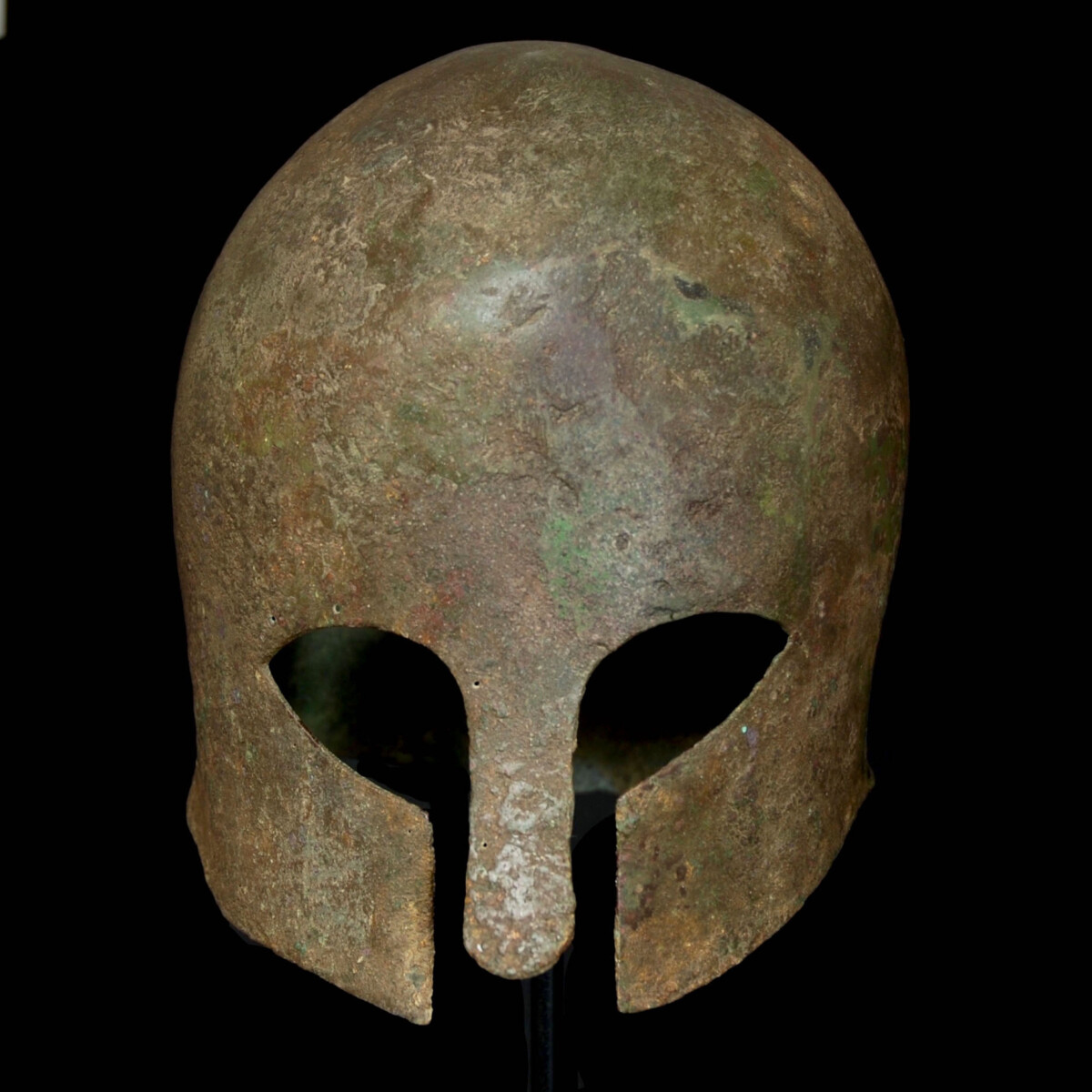
|
|
|
|
|
|
Greece – 7th-6th century B.C.
|
Early helmet of the second stage of the Corinthian type. The archaic head guard is hammered from one thick piece of bronze sheet and has long, towards the front tapering cheek pieces. The nose guard is almost of the same length, straight and slightly bent outwards. The eyes are almond-shaped and tapering outwards. The spherical calotte with a far protruding round back of the head, merging at the bottom to a subtly projecting neck guard. Around the eyes perforations for attaching the lining, possibly in leather. A very early, rare helmet of a hoplite from the archaic period. See for the type “Antike Helme, Sammlung Lipperheide und andere Bestände des Antikenmuseums Berlin”, Mainz 1988, pages 65ff. As well as Randolph Hixenbaugh “Ancient Greek Helmets, a complete guide and catalogue”, New York 2019, C262 page 375 and C442 page 615. Mounted.
|
Provenance: With Steen Strømberg, Copenhagen, Denmark prior to 2000. From there acquired by Peter Mustoner in 2004. With an old bronze collection lead and a copy of the 2004 invoice.
Dimensions: 21.5 cm high
Price: 60 000 Euro
|
|
|
Griechenland – 7.-6. Jahrhundert v. Chr.
|
Früher Helm der zweiten Form des korinthischen Typs. Der archaische Kopfschutz ist aus einem Stück dickem Bronzeblech geschmiedet und hat lange, vorne zulaufende Wangenstücke. Der Nasenschutz ist annähernd gleich lang, gerade und leicht nach außen gebogen. Die Augen sind mandelförmig und nach außen spitz zulaufend ausgeschnitten. Die kugelförmige Kalotte mit weit auslaufendem, rundem Hinterkopf, der unten in einen minimal auskragenden Nackenschutz übergeht. Rund um die Augen Lochungen zur Anbringung des Innenfutters wohl aus Leder. Ein sehr früher seltener Helm eines Hopliten aus archaischer Zeit. Vergleiche zum Typus „Antike Helme, Sammlung Lipperheide und andere Bestände des Antikenmuseums Berlin“, Mainz 1988, Seiten 65ff. Sowie Randolph Hixenbaugh „Ancient Greek Helmets, a complete guide and catalogue”, New York 2019, C262 Seite 375 und C442 Seite 615. Gesockelt.
|
Provenienz: Mit Steen Strømberg, Kopenhagen, Dänemark vor 2000. Dort erworben von Peter Mustoner im Jahr 2004. Mit einer alten Sammlungsplombe aus Bronze und einer Kopie der Rechnung von 2004.
Höhe: 21,5 cm
Preis: 60.000 Euro
|
|
|
|
Selected Artworks of the Month:
|
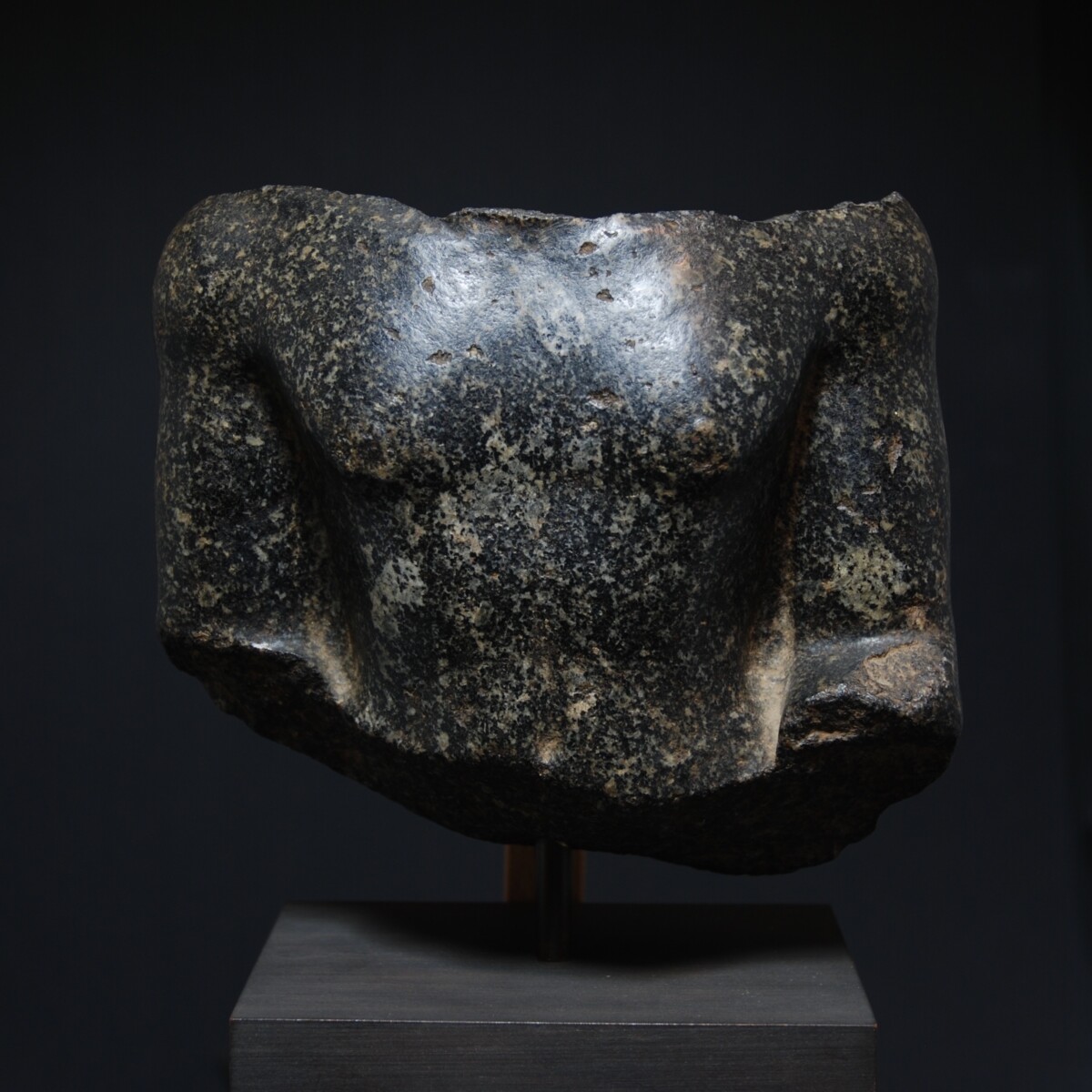
|
|
|
|
|
|
Egypt – Middle Kingdom, 12th dynasty, 1994-1648 B.C.
|
Large torso, which once belonged to a seated statue of a man. The shoulders are broad, the musculature is finely worked out in details, the navel pierced. The arms are bent forward and once rested on the lap. See for the type the about the same size, but completely preserved seated statue of the Chief of Police Mentuhotep in the Metropolitan Museum of Art with the Accession Number 22.1.200. Mounted.
|
Provenance: French private collection, acquired between 1960 and 1980. Thence with gallery Charles Ede in London. Since 2004 in an English private collection.
Dimensions: 15 cm x 17.5 cm
Price: 14 000 Euro
|
|
|
Ägypten – Mittleres Reich, 12. Dynastie, 1994-1648 v. Chr.
|
Großer Torso, der einst zu einer Sitzstatue eines Mannes gehörte. Die Schultern sind breit, die Muskulatur ist detailreich und fein ausgearbeitet, der Nabel gelocht. Die Arme sind nach vorne abgewinkelt und lagen einst am Schoß auf. Vergleiche zum Typus die etwa gleich große, jedoch vollständig erhaltene Sitzstatuette des Polizeichefs Mentuhotep im Metropolitan Museum of Art mit der Accession Number 22.1.200. Gesockelt.
|
Provenienz: Französische Privatsammlung, erworben zwischen 1960 und 1980. Danach in der Galerie Charles Ede in London. Seit 2004 in einer englischen Privatsammlung.
Höhe: 15 cm x 17,5 cm
Preis: 14.000 Euro
|
|
|
|
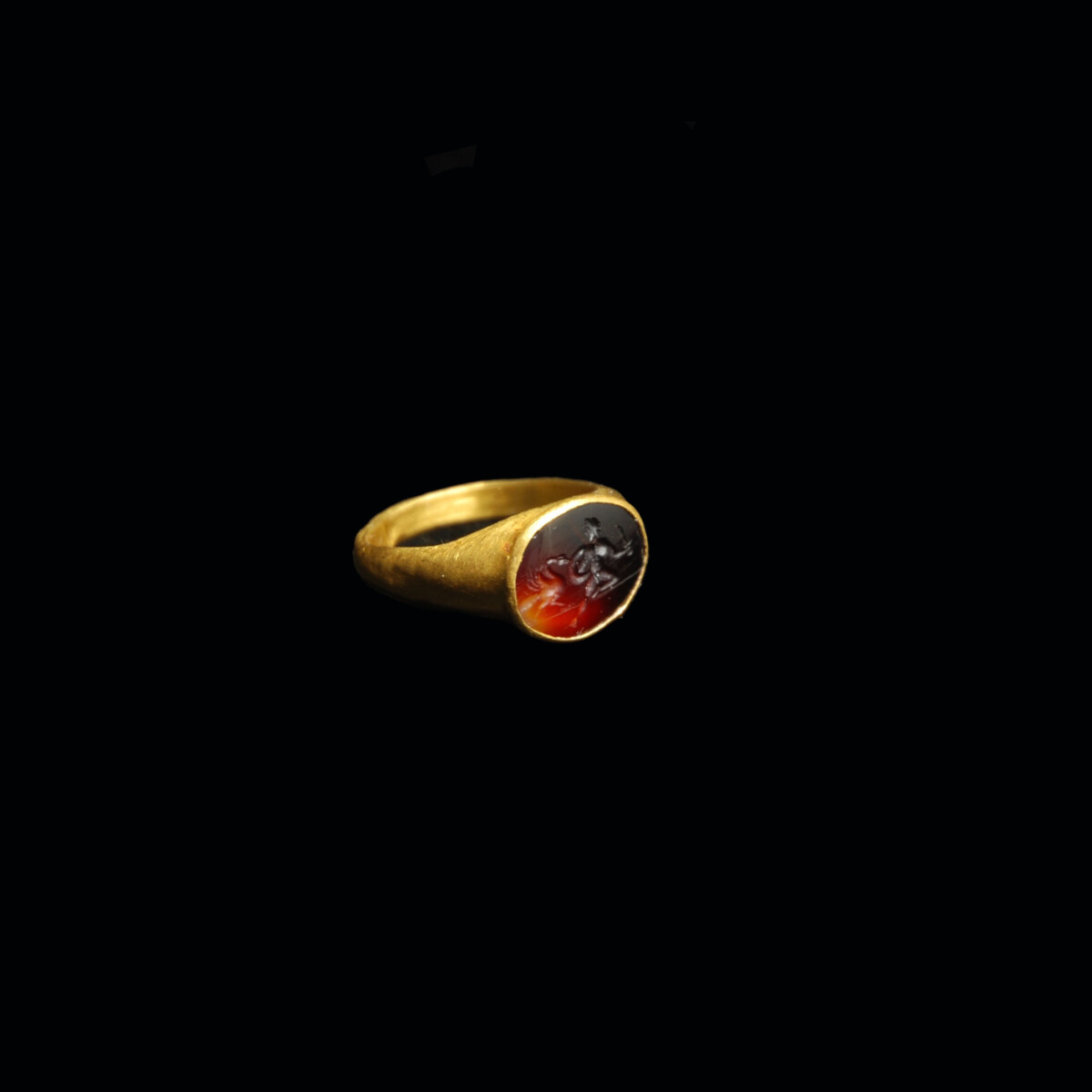
|
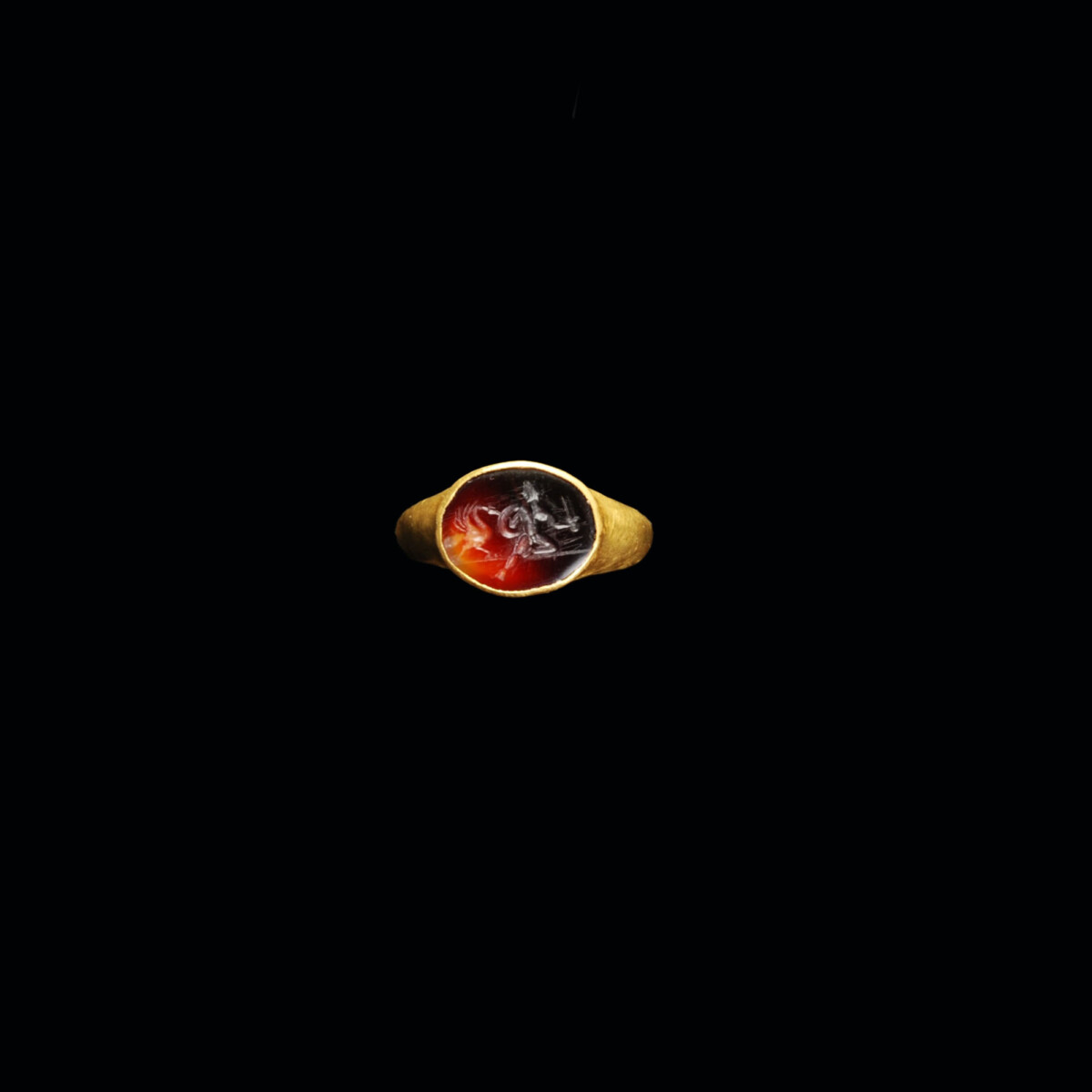
|
|
|
|
Roman Empire – 1st century A.D.
|
Completely preserved and ready-to-wear Roman gold ring with a carnelian cameo depicting a Capitoline goose who routs with its aggressive chatter a Gallic warrior with shield and sword to the right. While running, the warrior turns around to the goose who is after him with raised wings. The hollow ring band with a rounded hoop on the outside and flat on the inside. A high setting with an oval rim frames the finely cut intaglio. According to the legend the sacred geese of Juno rescued the Capitoline Hill from the conquest and plunder by the Gauls in 387 B.C. Since then, the aggressive bird was considered, especially in Roman Gaul, as the Celtic form of Mars. For example, geese were also buried next to warriors. Ready to wear.
|
Provenance: French private collection Karawani since the 1970s.
Dimensions: 2.1 cm in diameter (ring band); 5.6 gram
Price: 6 800 Euro
|
|
|
Römisches Reich – 1. Jahrhundert n. Chr.
|
Komplett erhaltener und tragbarer römischer Goldring mit Karneol-Gemme, die eine kapitolinische Gans zeigt, die durch ihr aggressives Geschnatter einen gallischen Krieger mit Schild und Schwert nach rechts in die Flucht schlägt. Der Krieger dreht sich im Laufschritt zu der Gans um, die ihm mit aufgerichteten Flügeln nachstellt. Der Ring mit außen abgerundeter und innen flacher Schiene ist hohl gearbeitet. Eine hohe, am Rand ovale Fassung umschließt die fein geschnittene Gemme. Der Legende zufolge retteten die heiligen Gänse der Juno das Kapitol in Rom vor der Eroberung und Plünderung durch die Gallier im Jahr 387 v. Chr. Seitdem galt der streitlustige Vogel vor allem im römischen Gallien als keltische Form des Mars. So wurden Gänse etwa auch neben Kriegern bestattet. Sofort tragbar.
|
Provenienz: Französische Privatsammlung Karawani seit den 1970er Jahren.
Durchmesser Ringschiene: 2,1 cm; Gewicht: 5,6 Gramm
Preis: 6.800 Euro
|
|
|
|
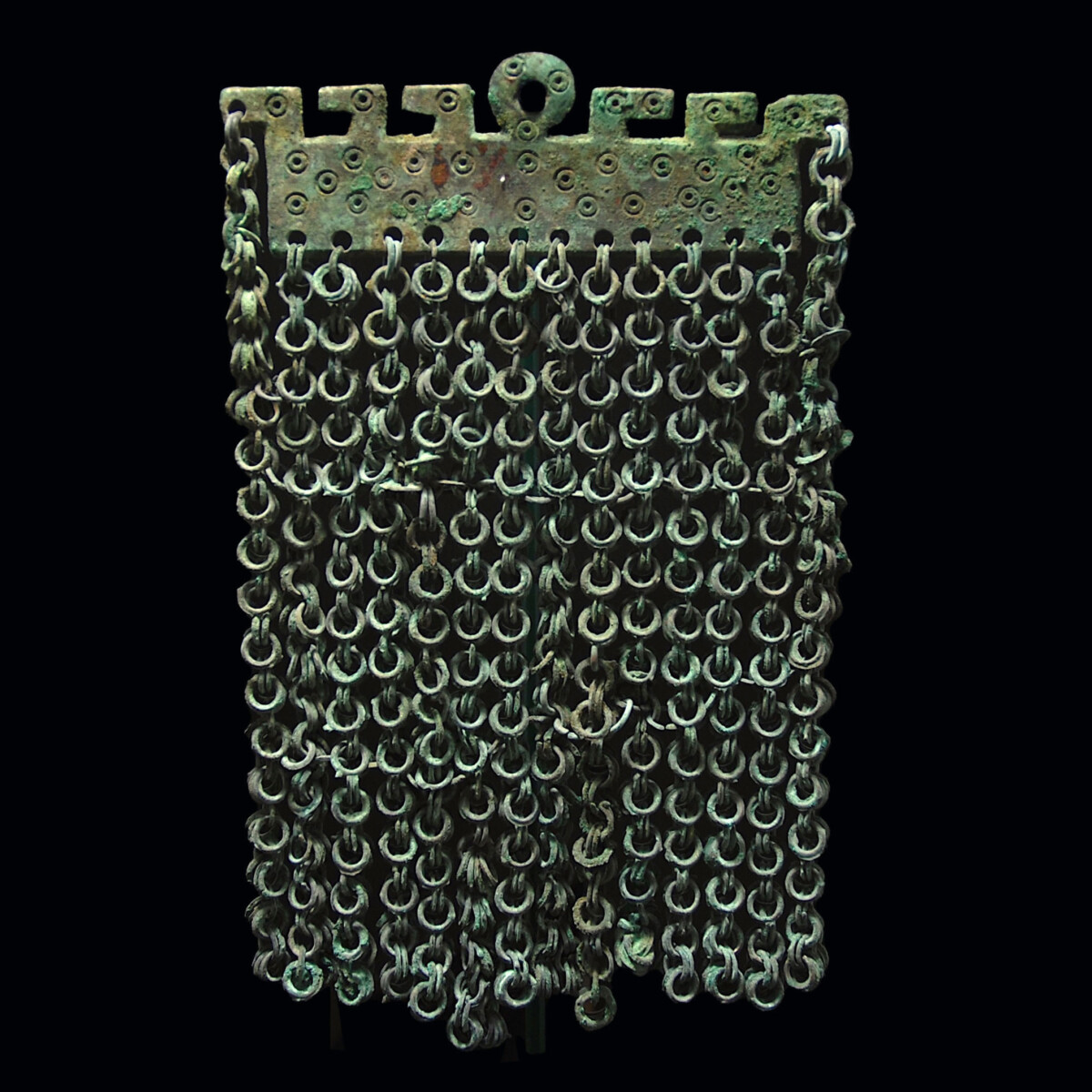
|
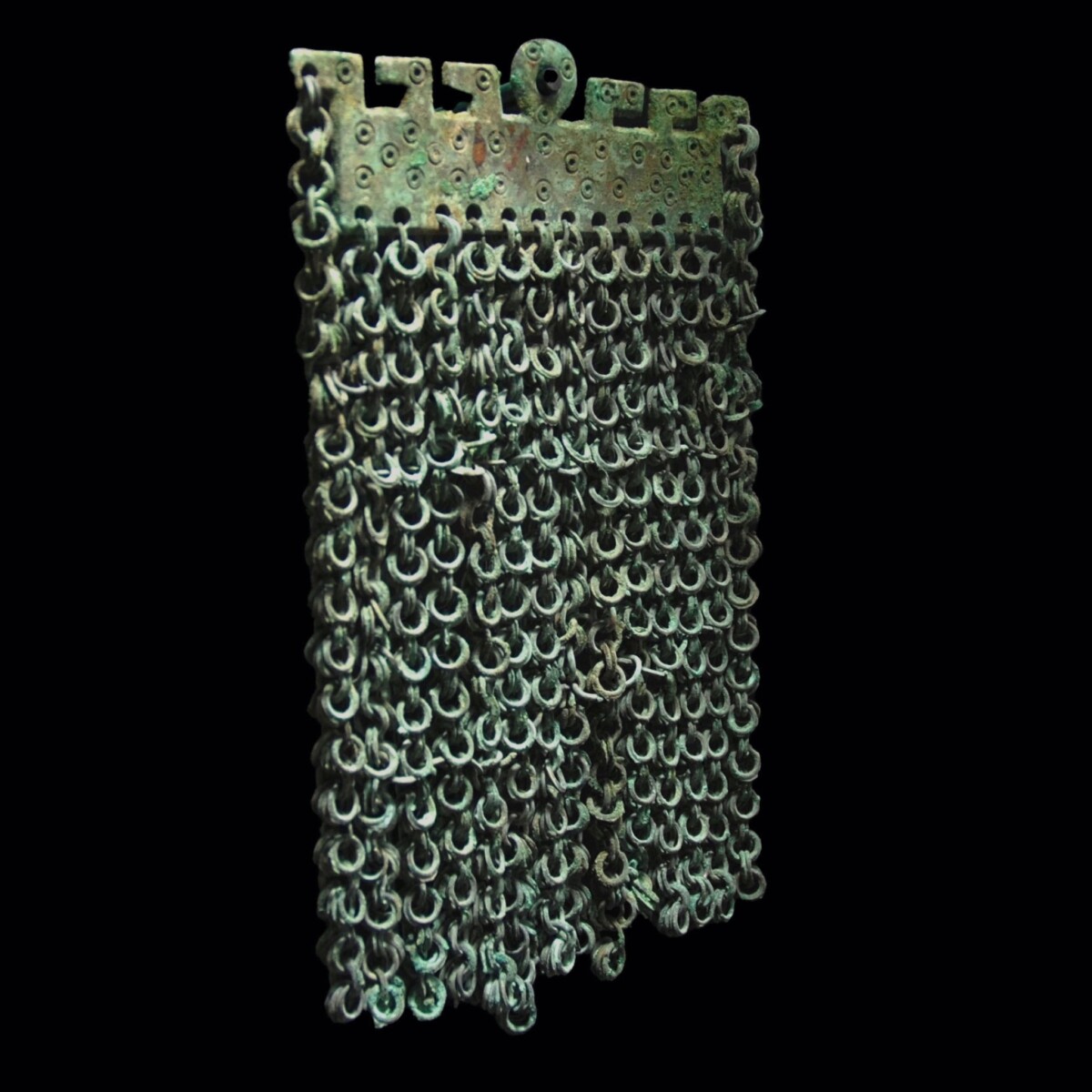
|
|
|
|
Middle Europe – 800-600 B.C.
|
Heavy bronze pendant crowned with stylized water birds. The animal heads with punched circular eyes are worked out from a rectangular bronze plate, which is also decorated with hallmarked circles. The outer birds with pierced beaks. A bronze chain made of joined pairs of bronze rings hangs in these beaks and in the 12 holes on the bottom of the bronze plate. The chains of bronze rings are also connected horizontally - once centrally in the upper part, the second time centrally in the lower part. Between the outward facing animal heads a round eyelet decorated with circular eyes for suspension of the entire ensemble. Bronze chains such as the present one can also be found on fibulas and pendants, e.g. in the Welterbemuseum in Hallstatt. The heavy pendant possibly once served as a body jewellery for special cults or for sepulchral purposes. Mounted.
|
Provenance: From a southern German private collection, last with a German auction house.
Dimensions: 26 cm x 15.3 cm
|
|
|
Mitteleuropa – 800-600 v. Chr.
|
Schweres Bronze-Gehänge, das von stilisierten Wasservögeln bekrönt wird. Die Tierköpfe mit gepunzten Augen sind aus einer rechteckigen Bronzeplatte gearbeitet, die ebenfalls mit Kreispunzen verziert ist. Die äußersten Vögel mit durchlochtem Schnabel. In diesen Schnäbeln sowie in den 12 Lochungen an der Unterseite der Bronzeplatte hängt jeweils eine Bronzekette aus zusammengefügten Paaren von Bronzeringen. Die Ketten aus Bronzeringen sind darüber hinaus auch horizontal – einmal mittig in der oberen, das zweite Mal mittig in der unteren Hälfte – miteinander verbunden. Zwischen den nach außen blickenden Tierköpfen eine runde, mit Kreisaugen versehene Öse zur Aufhängung des gesamten Ensembles. Bronzeketten wie diese finden sich auch auf Fibeln und Anhängern, etwa im Welterbemuseum Hallstatt. Das schwere Gehänge diente wohl einst als Körperschmuck für besondere Kulte oder im sepulkralen Bereich. Gesockelt.
|
Provenienz: Aus süddeutscher Privatsammlung, zuletzt in einem deutschen Auktionshaus.
Dimensionen: 26 cm x 15,3 cm
Preis: 6.000 Euro
|
|
|
|
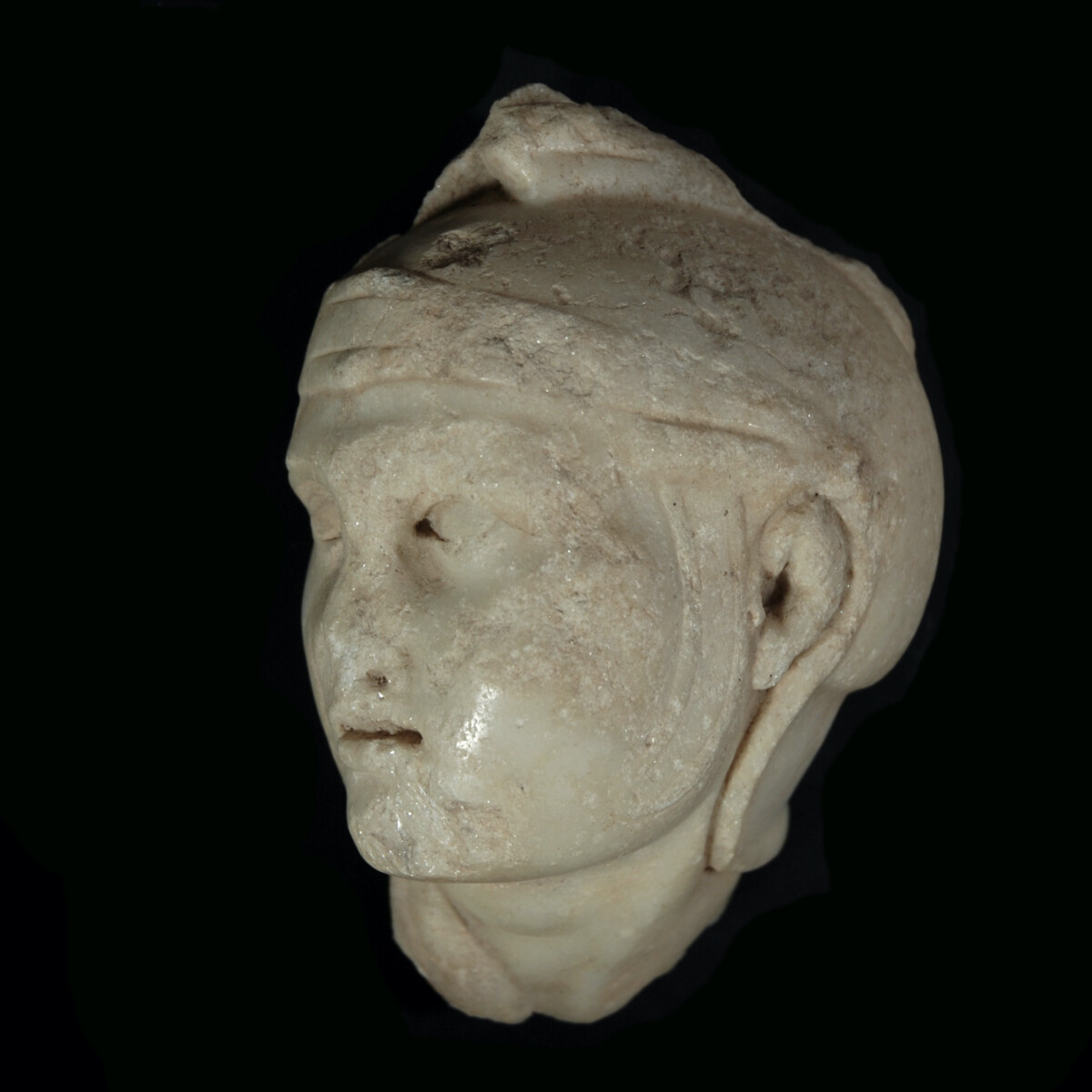
|
|
Greece/Attica – early 3rd century A.D.
|
Marble head of a young soldier worked out in high quality from an Attic workshop. The semi-sculptural head is from a relief of a sarcophagus. It depicts the young soldier facing to the right. He wears a helmet with a fitting neck guard, narrow cheek pieces, which reach to the chin, front plate, crest and plume. He has his vigilant eyes wide and his mouth slightly open. The tension in his features is clearly visible. Also of high quality is the detailed worked out neck part. Remains of a thrown over cape are still recognizable on his right side. The head may be from a sarcophagus with scenes of Achilles’ life. See for example: Sabine Rogge: „Die attischen Sarkophage. Achill und Hyppolytos. Die antiken Sarkophagreliefs”, Berlin 1995, no. 21, fig. 48. As well as the right side of the sarcophagus in Louvre from the Borghese collection „Achilles am Hof des Lykomedes“ with the inventory number Ma 2120. For the type also: Erika Simon “The Kurashiki Ningawa Museum. Greek Etruscan and Roman Antiquities”, Mainz 1982, no. 177, page 265. Mounted.
|
Provenance: Antikenkabinett Bernd Gackstätter with the list number 01437. With original certificate from the Antikenkabinett Gackstätter and a handwritten note by Bernd Gackstätter. Most recently in a Munich collection of ancient idols.
Dimensions: 13,2 cm x 9,5 cm
Price: 6 000 Euro
|
|
|
Griechenland/Attika – Anfang 3. Jahrhundert n. Chr.
|
Hochwertig gearbeiteter Marmorkopf eines jungen Soldaten aus einer attischen Werkstatt. Der halbplastische Kopf stammt von einem Relief auf einem Sarkophag. Es zeigt den jungen Soldaten nach rechts gewandt. Er trägt einen Helm mit anliegendem Nackenschutz, schmalen Wangenklappen, die bis zum Kinn reichen, Stirnblech, Kamm und Helmbusch. Er hat die wachen Augen weit und den Mund einen Spalt geöffnet. Die Anspannung in seinen Zügen ist deutlich ausgeprägt. Von hoher Qualität ist auch die detailreich gearbeitete Halspartie. Reste eines übergeworfenen Mantels sind an seiner rechten Seite noch erkennbar. Der Kopf dürfte von einem Sarkophag mit Szenen aus dem Leben des Achilles stammen. Vergleiche etwa: Sabine Rogge: „Die attischen Sarkophage. Achill und Hyppolytos. Die antiken Sarkophagreliefs“, Berlin 1995, Nr. 21, Tafel 48. Sowie die rechte Seite des Sarkophags im Louvre aus der Sammlung Borghese „Achilles am Hof des Lykomedes“ mit der Inventarnummer Ma 2120. Zum Typus weiters: Erika Simon „The Kurashiki Ningawa Museum. Greek Etruscan and Roman Antiquities“, Mainz 1982, Nr. 177, Seite 265. Gesockelt.
|
Provenienz: Antikenkabinett Gackstätter mit der Listennummer 01437. Mit Original-Zertifikat des Antikenkabinetts Gackstätter und einer handschriftlichen Notiz von Bernd Gackstätter. Zuletzt in einer Münchner Sammlung von antiken Idolen.
Dimensionen: 13,2 cm x 9,5 cm
Preis: 6.000 Euro
|
|
|
|
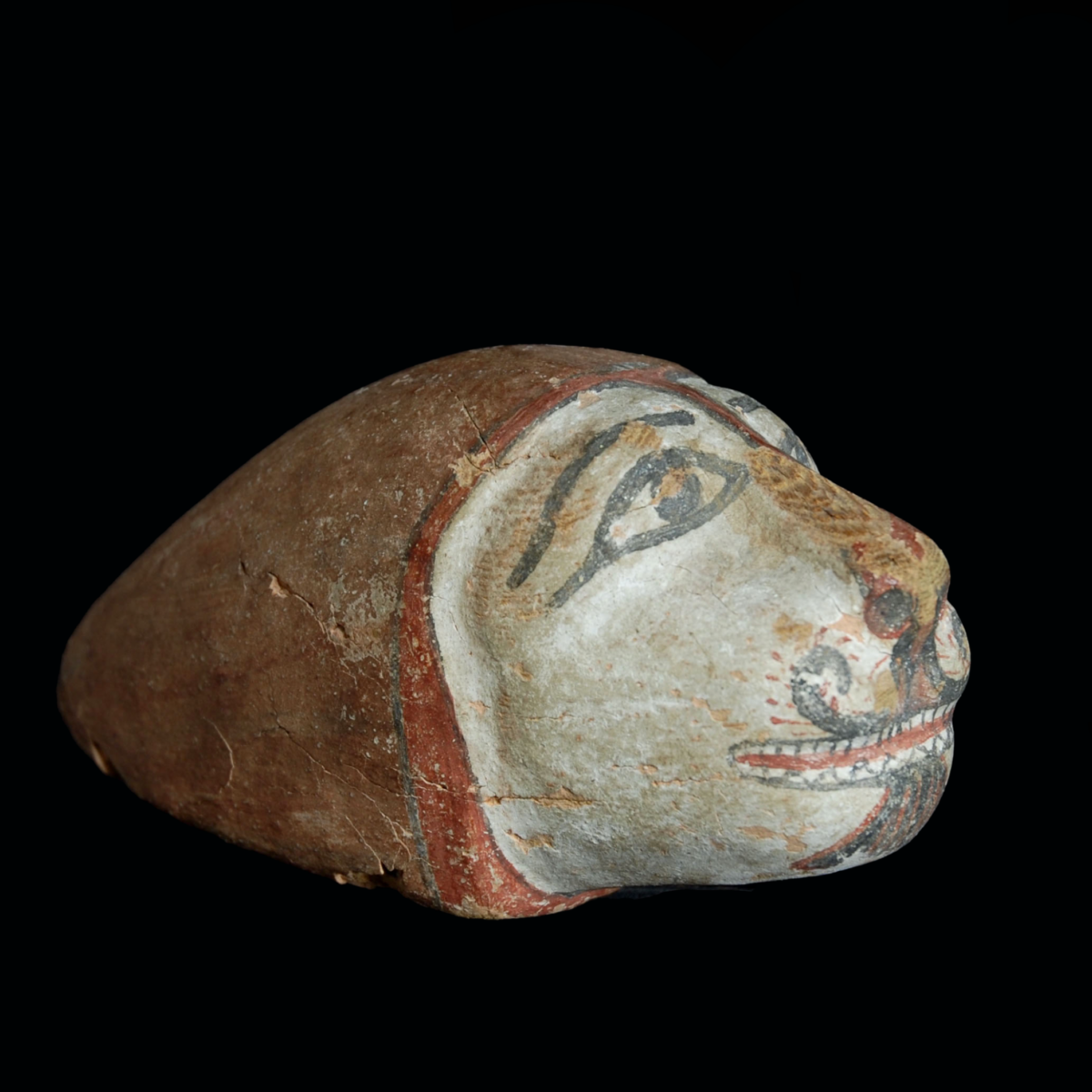
|
|
|
|
|
|
Egypt – Ptolemaic period, 2nd-1st century B.C.
|
Very charmingly painted wood head of a lion, which possibly served as an armrest on a chair. The lion with white primed face, black painted eyes with long eyeliner, curved brows and round pupils. Very striking is the slightly open mouth with a red tongue and a tightly set row of teeth, which create a smiling expression of the animal. The friendly expression is underlined by a moustache which is rolled in at the ends. The bottom of this wood attachment has a rectangular indentation with a central perforation, where the finale was mounted on the armrest. Published in: “Tiere und Mischwesen VIII”, catalogue 20, Basel 2008, number 5.
|
Provenance: Swiss collection Jürg Marquard, Herrliberg. Thence Galerie Cahn, Basel from 2007. Last in a US private collection.
Dimensions: 8.5 cm x 17.5 cm
Price: 2 400 Euro
|
|
|
Ägypten – Ptolemäische Zeit, 2.-1. Jahrhundert vor Chr.
|
Überaus reizvoll bemalter, hölzerner Kopf eines Löwen, der wohl als Armablage auf einem Möbel diente. Der Löwe mit weiß grundiertem Gesicht, schwarz gezogenen Augen mit langem Lidstrich, geschwungenen Brauen und runden Pupillen. Besonders auffällig ist das leicht geöffnete Maul mit roter Zunge und dicht gesetzter Zahnreihe, die dem Tier einen lächelnden Ausdruck verleihen. Der freundliche Ausdruck wird durch den an den Enden eingerollten Schnurrbart verstärkt. Die Unterseite dieses hölzernen Aufsatzes weist eine rechteckige Vertiefung mit zentraler Lochung auf, über die das Endstück an der Armlehne montiert war. Publiziert in: „Tiere und Mischwesen VIII“, Katalog 20, Basel 2008, Nummer 5.
|
Provenienz: Schweizer Sammlung Jürg Marquard, Herrliberg. Danach Galerie Cahn, Basel ab 2007. Zuletzt in einer US-Privatsammlung.
Dimensionen: 8,5 cm x 17,5 cm
Preis: 2.400 Euro
|
|
|
|
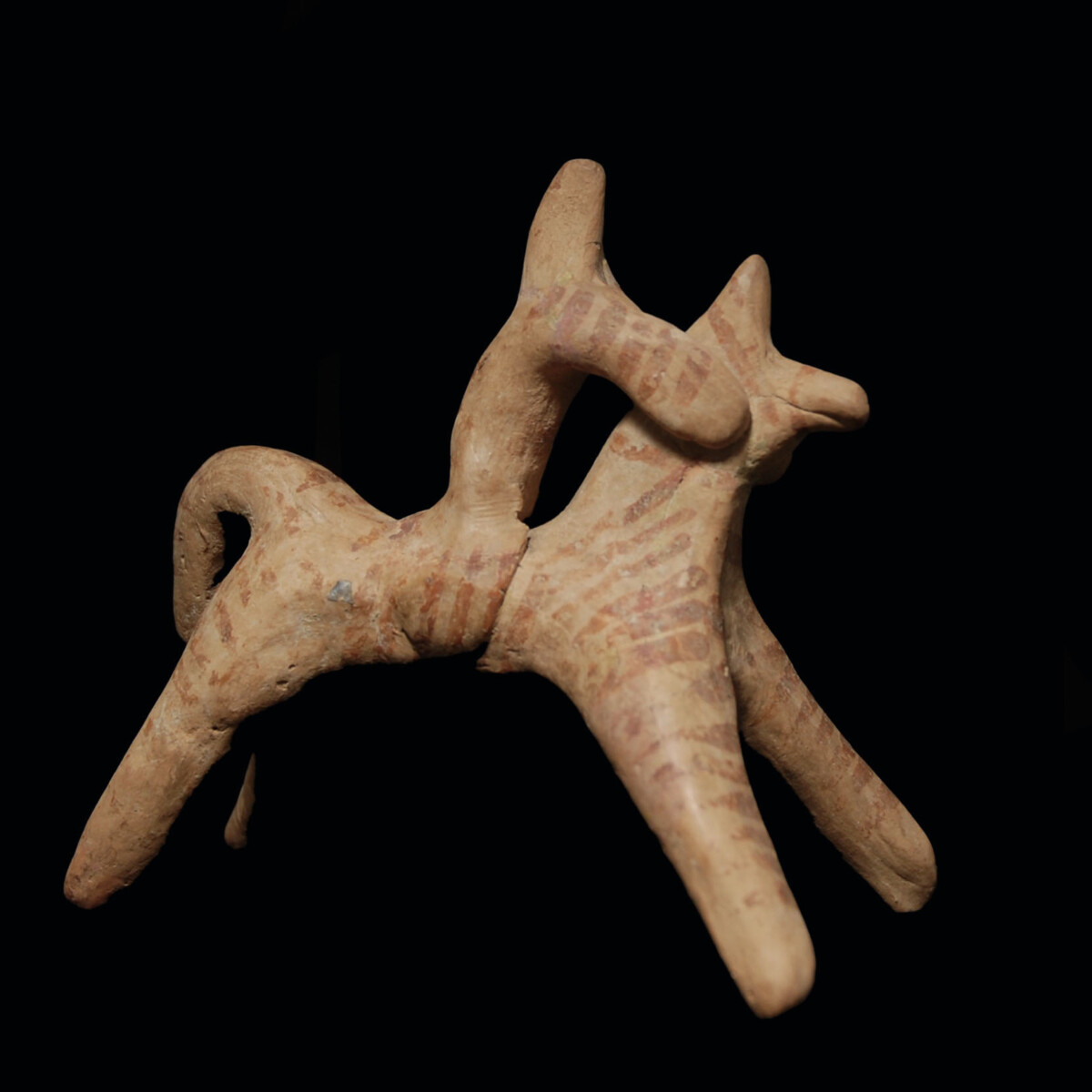
|
|
|
|
|
|
Greece/Boeotia – 6th century B.C.
|
Stylized terracotta statuette of a horse with rider. The animal with legs stretched out while running, a raised and downwards curved tail and a raised, pointy mane. The body is decorated with vertical, legs, head and tail are decorated with horizontal red-brown lines. The also stylized rider has his long arms placed on the head of the animal. His legs are wrapped around the belly. The head is flat and small. Statues such as the present one originate from a period, when the possession of a horse is associated with a high social ranking. They were found in tombs but also in temples. See for the type the example in the Kunsthistorisches Museum Wien, inventory number Antikensammlung V 1798.
|
Provenance: German private collection J. Gutbrod (died in 2017), acquired between the 1960s to the 1990s on the German art market. Thence by inheritance to Monika Gutbrod, Munich, Germany.
Dimensions: 9.2 cm x 10.3 cm
Price: 1 600 Euro
|
|
|
Griechenland/Böotien – 6. Jahrhundert v. Chr.
|
Stilisierte Terrakotta-Statuette eines Pferdes mit Reiter. Das Tier mit weggestreckten Beinen im Lauf, angehobenem und nach unten gebogenem Schwanz und aufgestellter, spitzer Mähne. Der Körper ist mit senkrechten, Beine, Kopf und Schwanz sind mit waagrechten rotbraunen Linien verziert. Der ebenfalls stark stilisierte Reiter legt seine langen Arme an den Kopf des Tieres. Seine Beine sind um den Bauch gewickelt. Der Kopf ist flach und klein. Statuen wie diese stammen aus einer Zeit, in der der Besitz eines Pferdes mit einem hohen sozialen Rang verbunden war. Sie wurden in Gräbern, aber auch in Tempeln gefunden. Vergleiche zum Typus die Statuette im Kunsthistorischen Museum Wien, Inventarnummer Antikensammlung V 1798.
|
Provenienz: Deutsche Privatsammlung J. Gutbrod (verstorben 2017), erworben in den 1960er bis 1990er Jahren am deutschen Kunstmarkt. Danach durch Erbe an Monika Gutbrod, München.
Dimensionen: 9,2 cm x 10,3 cm
Preis: 1.600 Euro
|
|
|
|
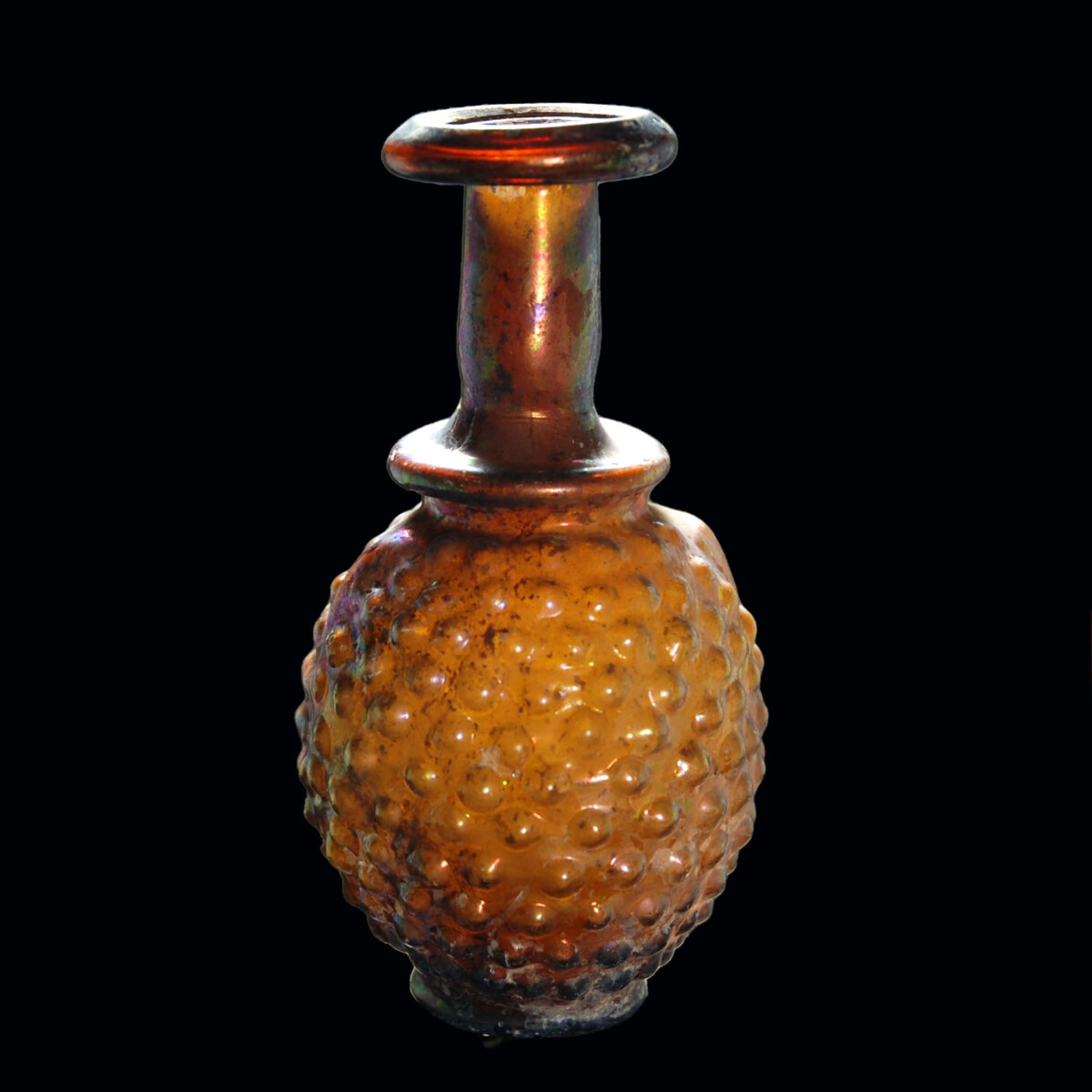
|
|
Roman Empire – 3rd century A.D.
|
Amber-colored, transparent glass flask with a horizontally, outwards and back again folded rim. The neck is long and cylindrical, constricted at the bottom. This is followed by a hollow, tubular collar that is open to the inside of the vessel. The body is oval, the base flat with a rib. The entire corpus is covered with eleven rows of stylized grapes. During production this part of the flask was blown into form, while the mouth and neck until the hollow rim were free blown. See for the type: “Römisches, byzantinisches und frühmittelalterliches Glas – Sammlung Ernesto Wolf”, Hatje Cantz 2001, number 72.
|
Provenance: From the estate of the French art dealer Evrard de Rouvre (1923-1979). Thence in the possession of his daughter Isabelle and her husband Francois van den Broek. Last in a family estate.
Dimensions: 12.8 cm high
Price: 4 800 Euro
|
|
|
Römisches Reich – 3. Jahrhundert n. Chr.
|
Bernsteinfarbene, durchsichtige Glasflasche mit horizontalem, nach außen gebogenem und wieder zurück gefaltetem Rand. Der Hals lang und zylindrisch, am unteren Ende eingeschnürt. Daran anschließend ein hohler, röhrenförmiger Kragen, der zum Gefäßinneren offen ist. Der Körper oval, der Boden flach mit Heftnarbe. Der gesamte Korpus wird von elf Reihen stilisierter Beeren bedeckt. Bei der Herstellung wurde dieser Teil der Flasche in die Form geblasen, während Mund und Hals bis zum Hohlkragen freigeblasen sind. Vergleiche zum Typus: „Römisches, byzantinisches und frühmittelalterliches Glas“ – Sammlung Ernesto Wolf“, Hatje Cantz 2001, Nummer 72.
|
Provenienz: Aus dem Nachlass des französischen Kunsthändlers Evrard de Rouvre (1923-1979). Danach im Besitz seiner Tochter Isabelle und ihres Mannes Francois van den Broek. Seitdem in Familienbesitz.
Höhe: 12,8 cm
Preis: 4.800 Euro
|
|
|
|

|
|
|
|
|
|
Etruria – 6th century B.C.
|
Charming terracotta head of an infant from an Etruscan sanctuary, possibly in Vulci. The infant with a friendly face, vigilant eyes between thick lids, the mouth formed into a smile and a childish snub nose as well as broad cheeks. The face is framed by a finely wavy cover. At the back it runs smoothly over the nape and the left shoulder, which is still preserved. Terracotta statuettes of swaddled infants such as the present one were found in various Etruscan sanctuaries. It is believed they represented both the wish for a child and the protection of the gods for a newborn. See for the typus the terracotta head of an infant, also with a wavy cover, from Vulci, today in the Villa Giulia in Rome, Italy.
|
Provenance: From the Emily and Walter Mead collection, Santa Fe, USA, acquired between 1960 and 1990.
Dimensions: 13.4 cm high
Price: 1 600 Euro
|
|
|
Etrurien – 6. Jahrhundert v. Chr.
|
Entzückender Terrakottakopf eines Kleinkindes aus einem etruskischen Heiligtum, wohl in Vulci. Das Kind mit freundlichem Gesicht, wachen Augen zwischen dicken Lidern, den Mund zu einem Lächeln geformt und kindlicher Stupsnase sowie breiten Backen. Das Gesicht ist von einem fein gewellten Umhang umgeben. Hinten fällt dieser glatt über den Nacken und den links erhaltenen Schulteransatz. Terrakotta-Statuetten von Wickelkindern wie diese wurden in verschiedenen etruskischen Heiligtümern gefunden. Es wird angenommen, dass damit sowohl der Wunsch nach einem Kind ausgedrückt, als auch der Schutz der Götter für ein Neugeborenes eingeholt werden sollte. Vergleiche zum Typus den Terrakottakopf eines Kindes, ebenfalls in einen gewellten Umhang gehüllt aus Vulci, heute in der Villa Giulia in Rom. Auf altem Holzsockel aus der Mitte des 20. Jahrhunderts.
|
Provenienz: Aus der Sammlung von Emily und Walter Mead, Santa Fe, USA, erworben zwischen 1960 und 1990.
Höhe: 13,4 cm
Preis: 1.600 Euro
|
|
|
|
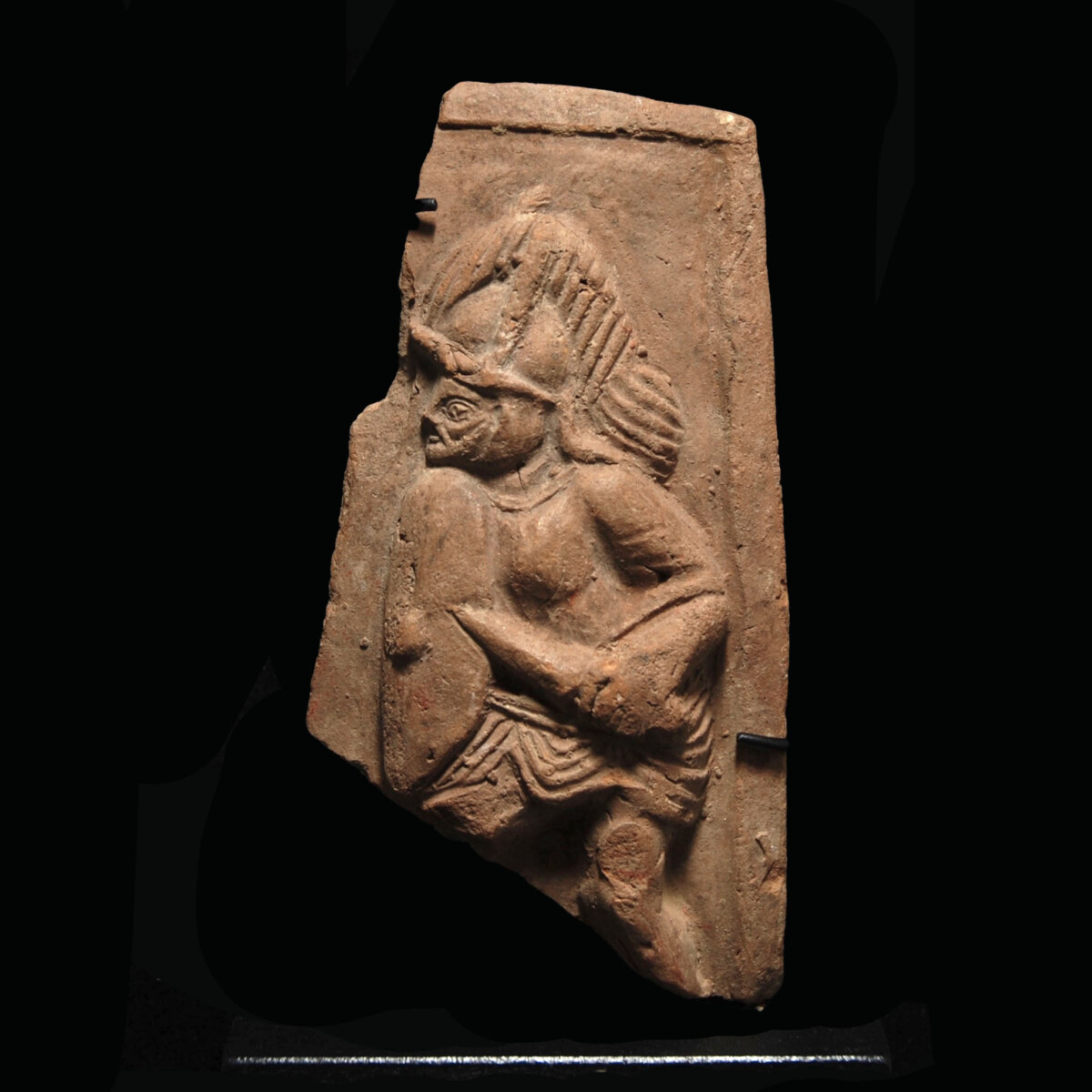
|
|
Roman Empire – 2nd century A.D.
|
A detailed terracotta relief of a gladiator of the Provocator type. The heavily armed combatant faces to the left, holds the sword (gladius) in his left hand and the shield (scutum) in front of his chest. He wears a helmet with a high crest, a cuirass, as well as a ribbed loincloth (subligaculum). The slightly curved relief could have adorned the shield of a larger statuette. Mounted.
|
Provenance: German collection Ingo Underberg, acquired on 26 June 2001 from Galerie Rhéa in Zurich, Switzerland. With the original invoice from 2001.
Dimensions: 12.7 cm high
Price: 1 800 Euro
|
|
|
Römisches Reich – 2. Jahrhundert n.Chr.
|
Detailgetreues Terrakottarelief eines Gladiators des Typs Provocator. Der schwer bewaffnete Kämpfer steht nach links gerichtet, hält das Kurzschwert (Gladius) in der linken Hand und den Schild (Scutum) vor der Brust. Er trägt einen Helm mit hohem Helmbusch, einen Brustpanzer sowie einen gerippten Lendenschurz (Subligaculum). Das leicht gewölbte Relief könnte das Schild einer größeren Statuette geschmückt haben. Gesockelt.
|
Provenienz: Deutsche Sammlung Ingo Underberg, erworben am 26. Juni 2001 bei der Galerie Rhéa in Zürich. Mit Original-Rechnung von 2001.
Höhe: 12,7 cm
Preis: 1.800 Euro
|
|
|
|
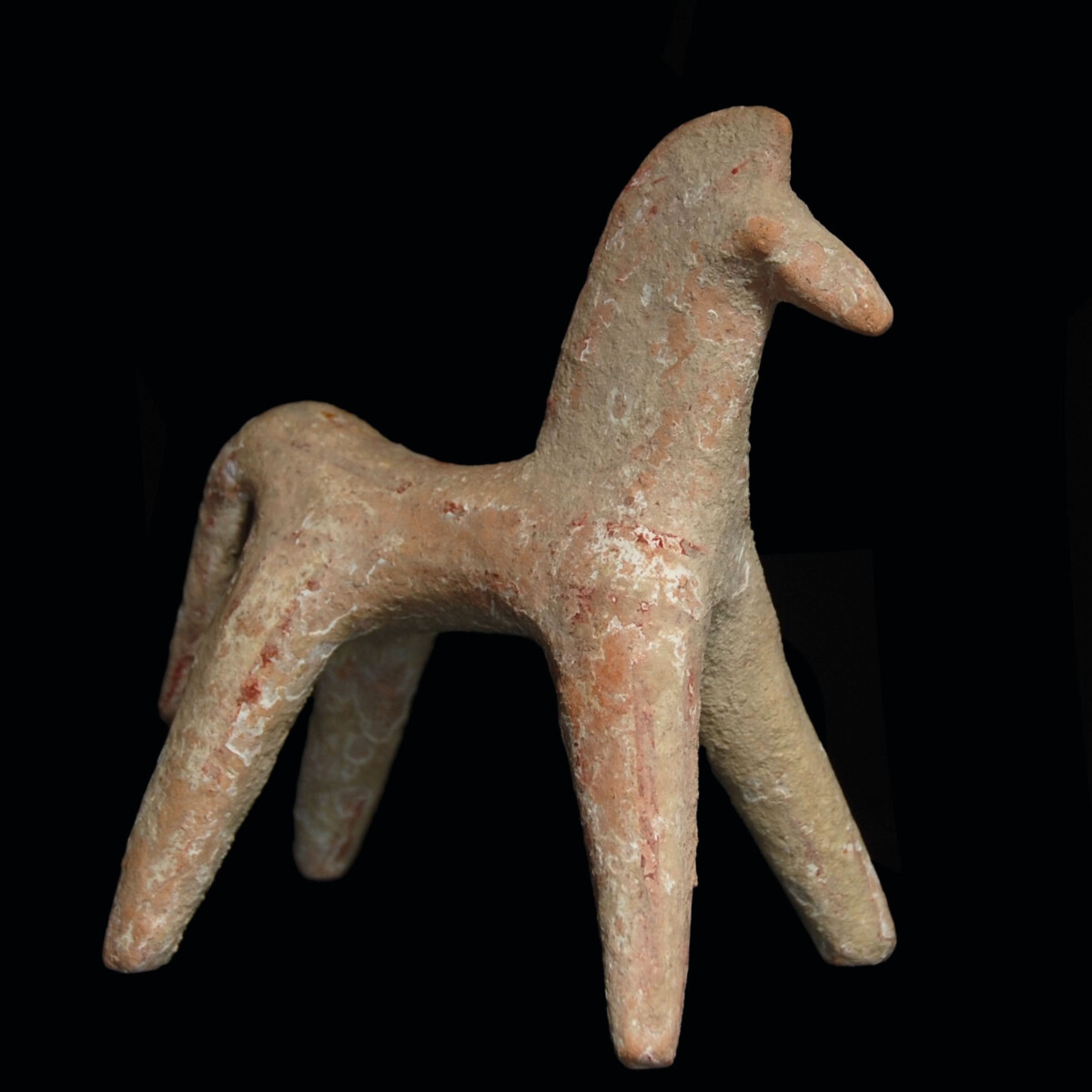
|
|
|
|
|
|
Greece/Boeotia – 6th century B.C.
|
Terracotta statuette of a horse in geometric style formed by hand. The corpus slender with four straight, slightly outwards stretched legs. The tail tapering downwards is long and slightly protruding. The head with a finely modelled snout, button eyes and an elegant, semi-circular mane.
|
Provenance: German private collection J. Gutbrod (died in 2017), acquired from the 1960s to 1990s in the German art market. Thence by descent to Monika Gutbrod, Munich, Germany.
Dimensions: 12.5 cm x 12.8 cm
Price: 900 Euro
|
|
|
Griechenland/Böotien – 6. Jahrhundert v. Chr.
|
Handgeformte Terrakotta-Statuette eines Pferdes im geometrischen Stil. Der Körper schlank mit vier geraden, leicht nach außen gestreckten Beinen. Der nachunten schmäler werdende Schwanz ist lang und leicht abstehend. Der Kopf mit fein modellierter Schnauze, Knopfaugen und einer eleganten, aufgerichteten, halbrunden Mähne.
|
Provenienz: Deutsche Privatsammlung J. Gutbrod (verstorben 2017), erworben in den 1960er bis 1990er Jahren am deutschen Kunstmarkt. Danach durch Erbe an Monika Gutbrod, München.
Dimensionen: 12,5 cm x 12,8 cm
Preis: 900 Euro
|
|
|
|
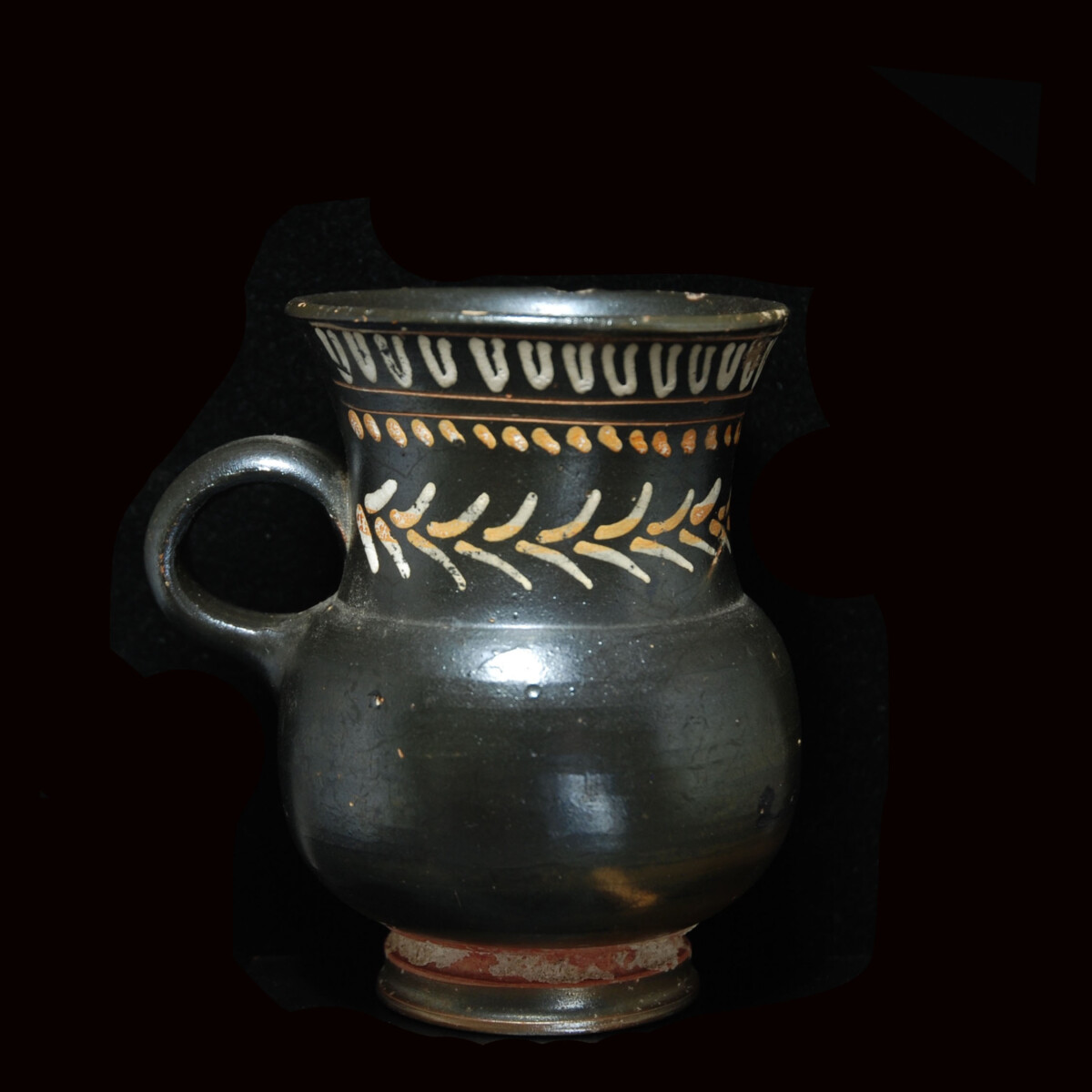
|
|
Greece/Apulia – 2nd half 4th century B.C.
|
Finely worked out, black-glazed jug with yellow and white paint. The bulbous corpus stands on a profiled, slightly set off ring foot. The neck is decorated with floral motives, grapes decoration and incised lines. Below the rim encircled egg-dart motive. The circular handle starts on the neck and ends on the shoulder. The rim funnel-shaped curved outwards.
|
Provenance: Viennese private collection Thibaut Lastel, for at least 20 years in a family estate.
Dimensions: 10.2 cm high
Price: 400 Euro
|
|
|
Griechenland/Apulien – 2. Hälfte 4. Jahrhundert v. Chr.
|
Fein gearbeitete, schwarz-glasierte Kanne mit gelber und weißer Bemalung. Der bauchige Korpus steht auf einem profilierten, leicht abgesetzten Ringfuß. Der Hals ist mit floralen Motiven, Traubendekor und Ritzlinien verziert. Unter dem Rand umlaufend Eierstabmuster. Der ringförmige Henkel setzt am Hals an und endet auf der Schulter. Der Rand trichterförmig nach außen gewölbt.
|
Provenienz: Wiener Privatsammlung Thibaut Lastel, seit mindestens 20 Jahren in Familienbesitz.
Höhe: 10,2 cm
Preis: 400 Euro
|
|
|
|
|
|
|
|
|
CHRISTOPH BACHER ARCHÄOLOGIE ANCIENT ART GmbH
|
Galerie: Stubenring 20, A-1010 Wien
Showroom: Untere Viaduktgasse 55, A-1030 Wien
|
|
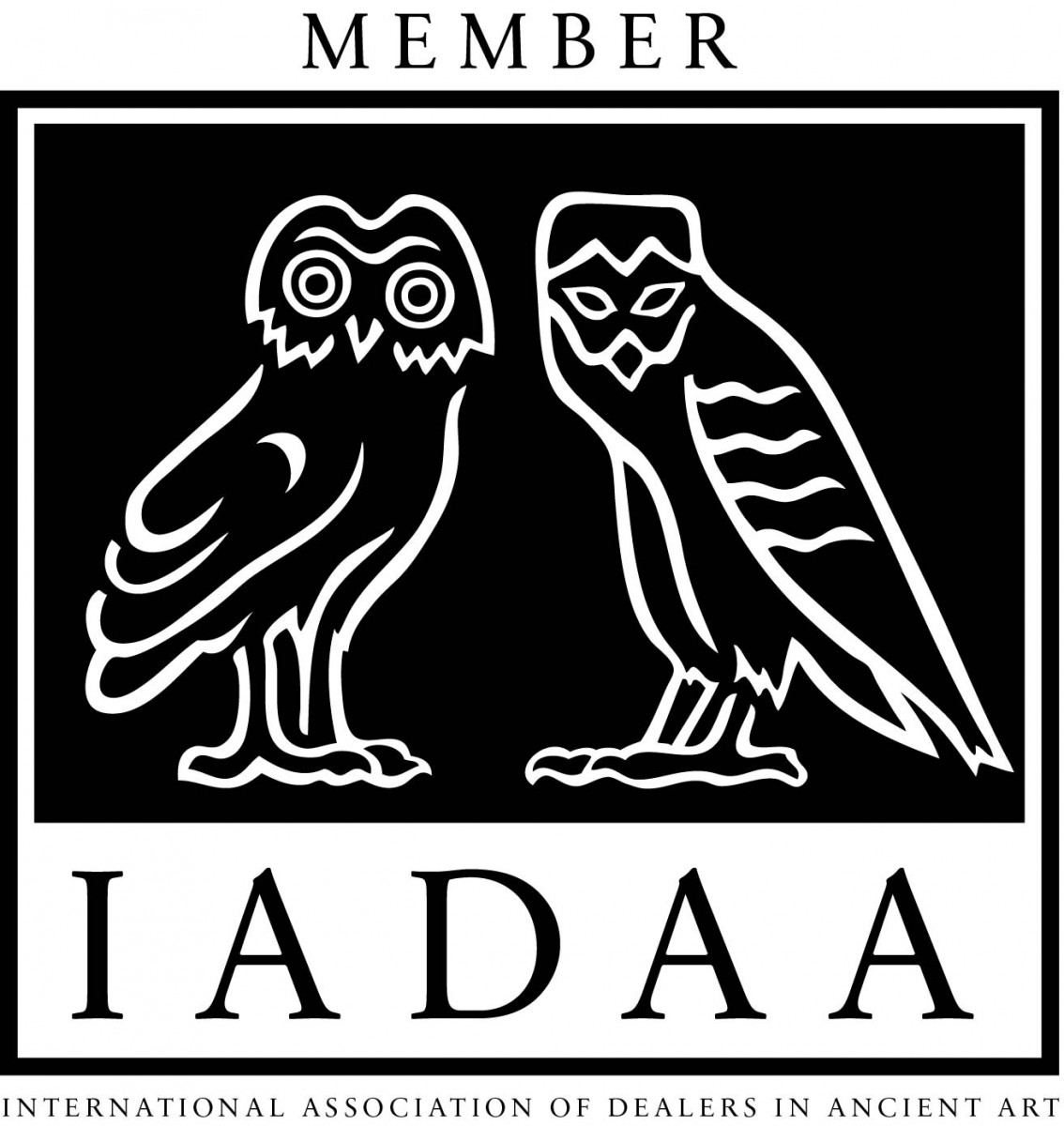
|
|
|
|
|
|